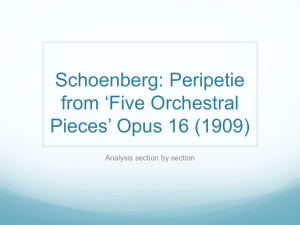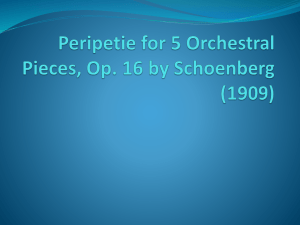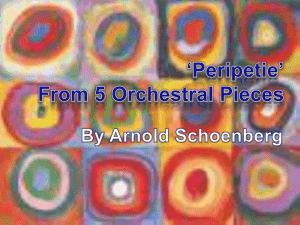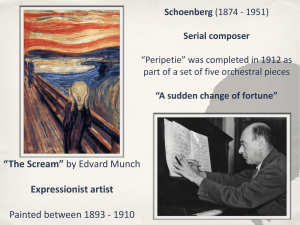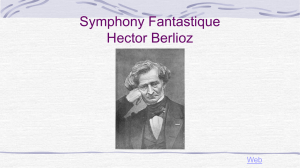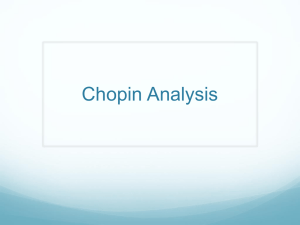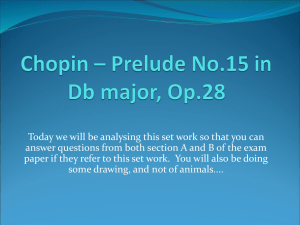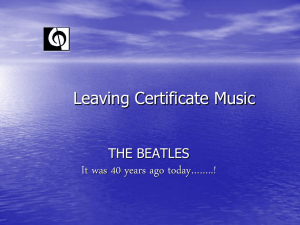Set Work Analysis – Peripetie
advertisement
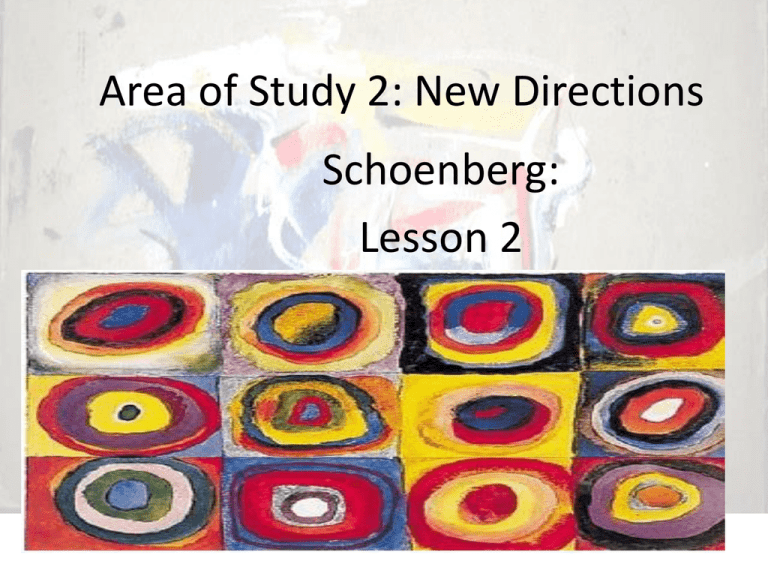
Area of Study 2: New Directions Schoenberg: Lesson 2 About Schoenberg • Arnold Schoenberg was born in Vienna in 1874 and died in 1951. • He was an Austrian composer associated with the expressionist movement in Germany poetry and art. • He was a gifted composer, teacher and painter and played the violin. • His music didn’t really take off even though he tried to convince major composers and conductors of the time with little success. • His music was condemned by the Nazis. • Schoenberg’s first compositions were Romantic in style, however, he started writing atonal music when his wife left him for his friend, a fellow artist! • His music became increasingly dissonant and chromatic in the style of Expressionism. The sense of key became less and less obvious eventually resulting in atonality. • Audiences and critics found Schoenberg’s atonal music difficult to understand. There was so much unrest at one concert that the police were called. Background to Five Orchestral Pieces • “Five Orchestral Pieces” by Arnold Schoenberg is a set of atonal pieces for full orchestra. • They all last between one to five minutes and are not connected to each other by the use of any thematic ideas. • In 1908 Richard Strauss, an established and popular composer of the time, asked Schoenberg to send him some short pieces to have a look at. He responded by writing this set of five pieces for full orchestra. • Composers did not understand his music and many simply dismissed them. • Strauss himself said, 'It would be better for him to shovel snow than to scrawl on music paper!' Schoenberg's reaction was to withdraw further into his small group of like-minded composers and pupils, more determined than ever to succeed in his original ideas • Peripetie is the 4th movement of Schoenberg’s “Five Orchestral Pieces”. • Peripetie means “sudden changes” in Greek. Hexachord 1. A hexachord is simply a set of 6 different notes 2. Schoenberg bases what can be described as the harmony of Peripetie on hexachords and derives many of his melodic ideas from the notes contained in the chords. Find the following in your pairs Listen to Peripetie with the score open in front of you. Try to find examples of the following and quote specific bars and parts where they happen. 1. 2. 3. 4. 5. 6. 7. 8. 9. Sehr Rasch: This is a tempo marking meaning ‘very quick’. Hexachord: chord based on 6 notes fff:This is a dynamic marking meaning very loud. Ruhiger: This is an expression marking and means ‘calmer’. Heftig: This is an expression marking and means ‘passionate’. Tremelo: This is an instrumental technique which means to play a pitch repeatedly and very rapidly. Klangfarbenmelodie: This means ‘tone colour melody’ and is to do with the idea of timbre being as important as the melody. Hauptstimme: Principal Voice: (see H-like symbol). Nebenstimme: Secondary Voice: (see N-like symbol). Answers 1. 2. 3. 4. 5. 6. 7. 8. 9. Sehr Rasch; This is a tempo marking meaning ‘very quick’, and is found at the very beginning of the piece. Hexachord; Bar 1 in clarinet parts, bar 3 in flute parts. fff; This is a dynamic marking meaning very loud and can be seen at bar 5 beat 3. Ruhiger; This is an expression marking and means ‘calmer’ and can be seen in the section between bars 44-58. Heftig; This is an expression marking and means ‘passionate’ and can be seen in the section between bars 44-58. Tremelo; This is an instrumental technique which means to play a pitch repeatedly and very rapidly. An example of this can be seen at the end of the piece in the double bass part. Klangfarbenmelodie; This means ‘tone colour melody’ and is to do with the idea of timbre being as important as the melody. An example of this can be seen in bars 24-28 in the brass. Principal Voice; Marked first in the horn part near the very beginning of the piece (see H-like symbol). Secondary Voice; Bar 28 beat 2 to bar 31 in trumpet 1 and bar 29 in the flutes, piccolo and clarinet. ‘Peripetie’ analysis • Free Rondo - 5 sections: – A B A’ C A’’ • Each section are of different lengths. • The tempo and texture change in each section • Melodic fragments and complicated, fragmented rhythms are used - based on the Hexachords - C#, D, E, F, G, A & A, A#, B, C, E, G# • Klangfarbenmelodie - ‘tone-colour-melody’: Technique that breaks up the melody across the different parts, varying the timbre - tone colour Analysis - Section A • SECTION A: BARS 1 - 18 – Clarinets and Flutes play 2 hexachords bar 1 and bar 3 – Fanfare horn motif - Hauptstimme - H: principle voice • Tempo/ Rhythm – Sehre rasch - very quickly – Short triplets and sextuplet – Bars 10 - 15 Clarinet Hauptstimme - expressive rubato • Instrumentation/ Texture – Brass dominated texture - bars 1 - 8 – Bars 8 - 18: Woodwind dominated texture – Ostinato rhythm bars 8 - 10 in the Bassoon and Clarinet – Texture thins after a series of hexachords to a solo Clarinet part – Bars 10 - 15 Clarinet homophonic texture Analysis - Section A • Pitch/ Melody – Atonal, built up of a series of hexachords – The full pitch range is heard by the orchestral instruments – Clarinet solo uses dissonant leaps of a minor ninth and major seventh/ diminished • Dynamics – At the beginning the piece is forte (loud) crescendo (gradually getting louder) to forte fortissimo (very very loud - fff) at bar 5 beat 3. This then diminuendo’s (gradually getting quieter) to pianissimo (very quiet/ soft) Analysis - Section B • SECTION B: BARS 18-34 – The Cello has the Hauptstimme at the beginning of this section bars 18 - 20 – This is picked up by the Trumpets from bars 18 - 19 – The Cello line plays in the top register indicating the business of the section • TEMPO/ RHYTHM – Original tempo however with shorter durations of notes it makes it feel like the section is a lot quicker • INSTRUMENTATION/ TEXTURE – The whole orchestra is used at different points leading up to Bars 30-34 there is a climax. This lead by the woodwind and percussion. – In contrast the strings have a soft line – Polyphonic texture Analysis - Section B • PITCH/ MELODY – The Hauptstimme is passed throughout the orchestra – Bars 24-28 - Klangfarbenmelodie in the Brass section – Bars 28 - 31 - The secondary voice (Nebenstimme) appears once in this piece…first in trumpet 1 part and then in the Woodwind • DYNAMICS – Starts of piano then there is an immediate crescendo. – The dynamics vary throughout the orchestral parts – The principle and secondary voices are marked f - fff – The change in dynamics from other parts is quite ‘restless’ Analysis - Section A1 • SECTION A’ - BARS 35 - 43 – This section beginnings the strings having the Hauptstimme – Bars 39 - 41 return of the hexachord played in bars 8 -10 by the Horns – A more menacing and tranquil mood to section B, however shorter than the first Section A Analysis - Section C • SECTION C: BARS 44-58 – Horns starts with a one bar Hauptstimme part that is passed onto the cello - marked solo • TEMPO/ RHYTHM – Tempo alternates between ruhiger (calmer) and heftig (passionate) • INSTRUMENTATION/ TEXTURE – Sparse texture at the beginning with different instruments having ‘solos’ up to bar 53 where the full orchestra come in • DYNAMICS – The dynamics range from pp bars 44 & 45 and fff bars 53 - 55 this then comes down to almost nothing in bar 58 Analysis - Section A2 • SECTION A’’: BARS 59 - 66 – Back to the original tempo • TEMPO/ RHYTHM – Many of the rhythmic ideas from the opening bars return – Bars 5 - 6 is the same as bars 61-63 in the trumpet parts – Bar 1 and bars 59-61 in the Clarinet part – Bar 3 and bars 62-63 in the Flute part • INSTRUMENTATION/ TEXTURE – The section begins with the Clarinets and strings. – The instruments are introduced one by one - layering the repeated rhythmic motifs – The orchestra comes together for the final climatic chord bar 64 Analysis - Section A • PITCH/ MELODY – – – – There is no Hauptstimme The material used in the opening is developed Bar 64 uses a hexachord with most of the orchestra. The Double basses play a tremolo chord top in the register which continues after the orchestra have finished their parts • DYNAMICS – A big crescendo between bars 59 - 64 from pp - fff – This dies down immediately to pp in the Double bass part and Horns section
